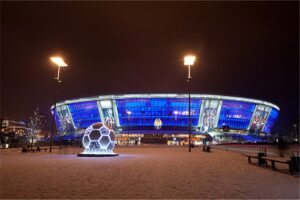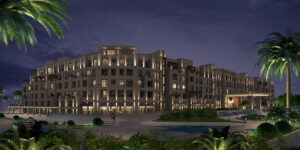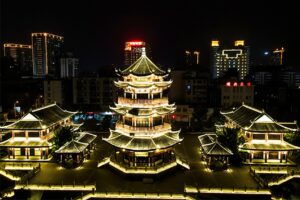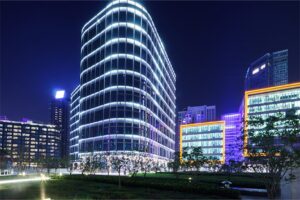In the course of servicing customer lighting projects, we’ve encountered various issues with the design of lamps and lanterns, leading to a shorter product lifespan than originally planned. This brief discussion focuses on common problems in the design of outdoor LED lighting and their solutions, offered for reference.
Regarding the service life of LED lamps in architectural lighting projects, failure is not only indicated by the most obvious signs, such as the LEDs no longer illuminating or displaying abnormal color changes. Another critical standard for determining product failure is the LED luminous flux maintenance rate. If this rate falls below 70% (meaning there’s more than 30% light attenuation), the lamp can be considered to have reached the end of its service life. With this criterion in mind, let’s explore some common solutions to these issues.

LED Chip
Firstly, let’s discuss the LED chip program. The LED chip is fundamental to any LED lamp, acting as its light source. The core design objective is to ensure that the LED chip remains reliably illuminated while maintaining a reasonable rate of light decay. A key parameter here is the rated junction temperature. The higher this temperature rating, the better the chip’s ability to withstand high temperatures.
For instance, conventional chips typically have a rated junction temperature of around 125°C. This implies that as long as the chip’s junction temperature remains below this threshold when powered, it will function correctly, and the rate of light decay will stay within an acceptable range.
Conversely, a lower junction temperature during operation means higher luminous efficiency and a slower light decay rate, thus extending the chip’s lifespan. On the flip side, a higher junction temperature when lit results in lower luminous efficiency, a faster light decay rate, and a shorter lifespan.
For an LED chip of a given size, the larger the current used to drive it, the more heat it generates. Conversely, for a constant drive current, a larger chip size results in less heat generation. The ideal solution, therefore, is to use a larger chip with a smaller driving current, as this enhances luminous efficiency and reduces heat, ultimately prolonging service life.
However, cost is a significant factor in practical applications. Thus, selecting a chip of the appropriate size and cost, which aligns with actual needs, represents a balanced and reasonable approach.
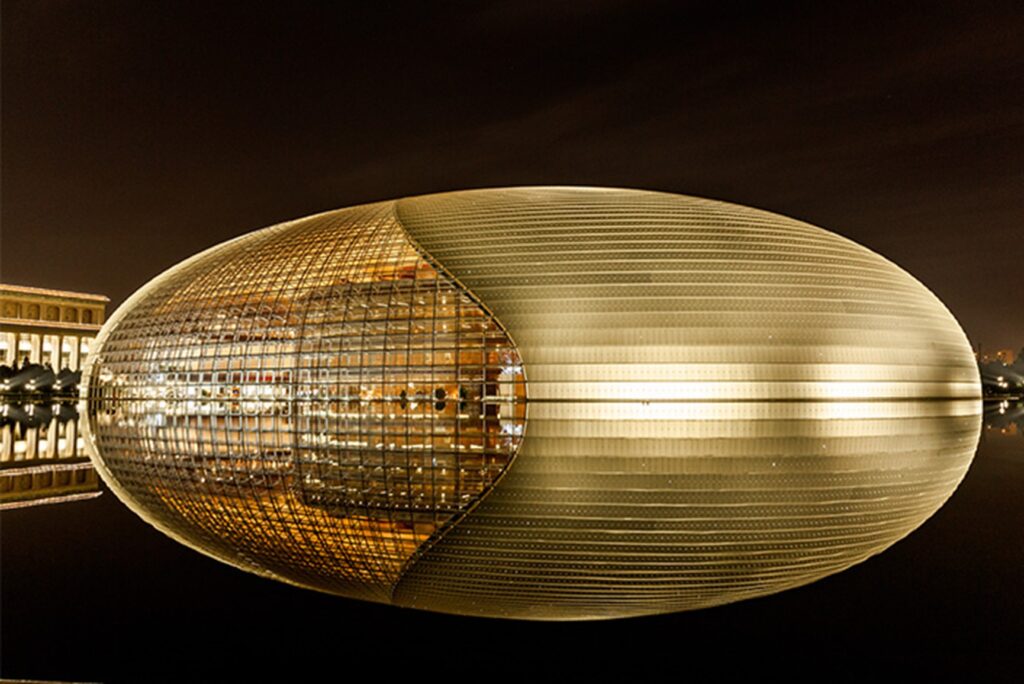
Encapsuation: SMD and COB
Secondly,the LED chip is the core component for light emission, but it requires encapsulation before use. The most common packaging methods are SMD (Surface-Mount Device) and COB (Chip On Board).
SMD lamp beads are known for their flexibility and compatibility across various lamp types, ranging from low to ultra-high power. These beads, combined with PCB (Printed Circuit Board) assembly, facilitate effective heat conduction from the chip to the lamp’s cooling structure, maintaining a reasonable junction temperature and minimizing light attenuation.
In contrast, COB light sources encapsulate the chip on a compact substrate, concentrating the heat during illumination. This requires stringent control of junction temperature and efficient heat dissipation structures. Typically, COB is used for lower-power products like spotlights, while SMD is more common for higher power applications.
In the SMD approach, the lamp beads are mounted onto the PCB board using SMT (Surface-Mount Technology). To ensure optimal thermal conductivity, the PCB’s copper foil thickness is crucial, with a general minimum of 18 ounces. For special projects, where maintenance is challenging, a thickness of 35 ounces, or even 70 ounces, is recommended. This thickness aids in transferring the heat from the lamp beads to the lamp shell more effectively, thereby controlling the junction temperature and enhancing the service life.
Different PCB materials offer varying heat dissipation properties, with the hierarchy being glass fiber board < aluminum substrate < copper substrate. For outdoor lamps, low-power products often use fiberglass or aluminum substrates, while medium to high-power products are better served with aluminum substrates. Super high-power or size-constrained applications might require a copper substrate, although this incurs higher costs.
When using a COB light source, the packaging substrate is usually aluminum or ceramic. It’s essential to ensure a close fit between the COB substrate and the lamp shell to optimize heat dissipation

The shell of lamps and lanterns
The shell of lamps and lanterns serves a dual purpose: not only must it be aesthetically pleasing, but it also needs to fulfill critical functional requirements, primarily in heat dissipation and protection. Protection includes compliance with IP (Ingress Protection) and IK (Impact Protection) levels, along with specific demands like explosion-proofing in special project scenarios.
A well-designed shell ensures efficient heat dissipation from the LED light source, allowing the LED chip to operate within its rated junction temperature and maintain a reasonable lifespan.
When designing a shell, the power range compatibility of each model is determined. To assess the thermal performance of a shell in normal usage or testing, a simple method is employed. After assembling a finished lamp, it’s powered on under normal lighting conditions and left lit for at least four hours to reach thermal equilibrium.
Then, the temperatures of the lamp’s shell and substrate are tested to check if they fall within the designed temperature range. Meeting these criteria indicates effective heat exportation from the light source to the shell and efficient heat dissipation by the shell, ensuring proper functioning of the chip.
Moreover, the shell must meet specific protection standards. For instance, outdoor floodlights need to comply with at least an IP65 protection level. Failing to meet this standard can lead to leakage accidents in outdoor settings, and components such as PCB boards and lamp beads could suffer from moisture damage, severely shortening the product’s lifespan. Thus, adhering to the required protection level is not just a design standard but a critical aspect of the lamp’s functionality

The drive power supply
The drive power supply is a crucial component in the current LED lamps and lanterns system. The efficiency and functionality of a lamp depend heavily on this element, irrespective of the quality of the LED chip, substrate, or shell. If the driver power supply is substandard, the lamp may fail to illuminate or reach its expected lifespan. Therefore, selecting an appropriate power supply is vital for several reasons:
- Ensuring Normal Operation: A well-chosen power supply ensures that the lamps can light up and function correctly.
- Stability: A high-quality drive power supply maintains stable input and output voltage and current parameters, which is essential for the steady operation of the LED chip.
- Environmental Suitability: Depending on the installation location, it might be necessary to choose a power supply that is resistant to rain or fully waterproof.
- Power Utilization: It’s advisable to use the power supply within its optimal capacity, leaving a certain margin. Particularly with constant voltage power supplies, it’s recommended to reserve at least a 20% margin. This practice helps in maintaining the stability and prolonging the life of the power supply.
Therefore, the choice of drive power supply not only impacts the immediate functionality of the lamp but also its long-term reliability and effectiveness. A carefully selected power supply, considering the factors above, contributes significantly to the overall performance and durability of LED lamps and lanterns

Wiring
Wiring plays a vital role in the safety and efficiency of LED lamps and lanterns but is frequently underestimated. An improper choice in wire gauge can lead to significant risks. If the wire is undersized, it can become excessively hot or even overheat to the point of burning out, posing a substantial safety hazard.
Therefore, in the design process, careful calculation is essential when selecting wire sizes. It’s not just about choosing wires that can handle the expected current load; it’s also crucial to incorporate a safety margin.
This precaution ensures that the wires can manage occasional surges or increases in load without compromising safety or performance. Adequate wire sizing, coupled with a consideration for safety margins, is a fundamental aspect of the design that ensures the longevity and reliability of LED lighting systems

The environmental conditions of the installation site
When designing LED lighting systems, it is crucial to thoroughly understand the environmental conditions of the installation site. Several factors can significantly impact the design choices:
- Voltage Stability: In underdeveloped areas, voltage instability is a common issue. Large voltage fluctuations necessitate designs that emphasize surge protection and other electrical stability measures.
- Corrosive Environments: Proximity to the sea or salt lakes, where salt spray corrosion is a concern, requires the selection of materials and components that can withstand such conditions.
- Extreme Temperatures: High-temperature environments demand materials and designs that can tolerate heat without degradation. Conversely, in areas with super-low temperatures (below -40°C), it’s essential to determine if the lighting needs to operate in such conditions. If so, the power supply and other components must be capable of functioning reliably at these low temperatures.
- Weather Challenges: For sites prone to hurricanes, typhoons, or thunderstorms, the physical robustness of the lighting fixtures becomes paramount. This includes ensuring that mounting brackets and structural components are sufficiently strong and durable to withstand such extreme weather.
Understanding and addressing these environmental factors in the design phase is vital for the durability, safety, and functionality of the lighting installation. Tailoring the design to suit specific site conditions ensures that the lighting system will perform reliably under the unique challenges it may face

In Conclusion
The points discussed above revolve around key design considerations to ensure the optimal service life of LED lamps and lanterns. In actual project implementation, it’s crucial to tailor these ideas to meet the specific needs of the customer and the unique conditions of the project site.
This involves a thorough and reasoned approach to program design and selection, taking into account all relevant factors—from the choice of LED chips and drive power supply to the environmental conditions of the installation site. By addressing these elements from the outset, we aim to guarantee the prolonged and efficient service life of LED lamps and lanterns.
This holistic approach not only enhances the performance and reliability of the lighting systems but also ensures customer satisfaction and the success of the project. Any interesting or problem, please feel free to contact Solutionproled.com

